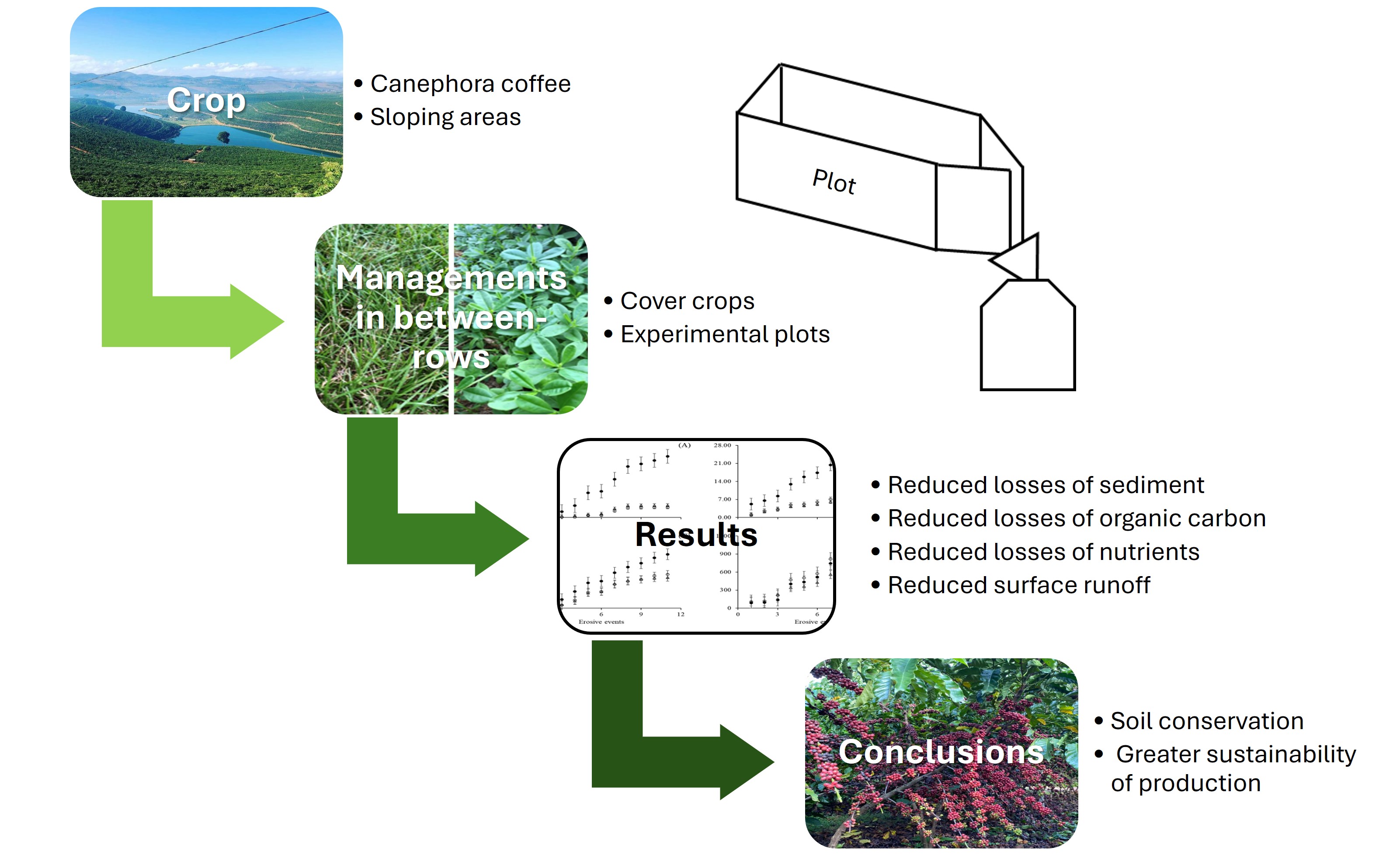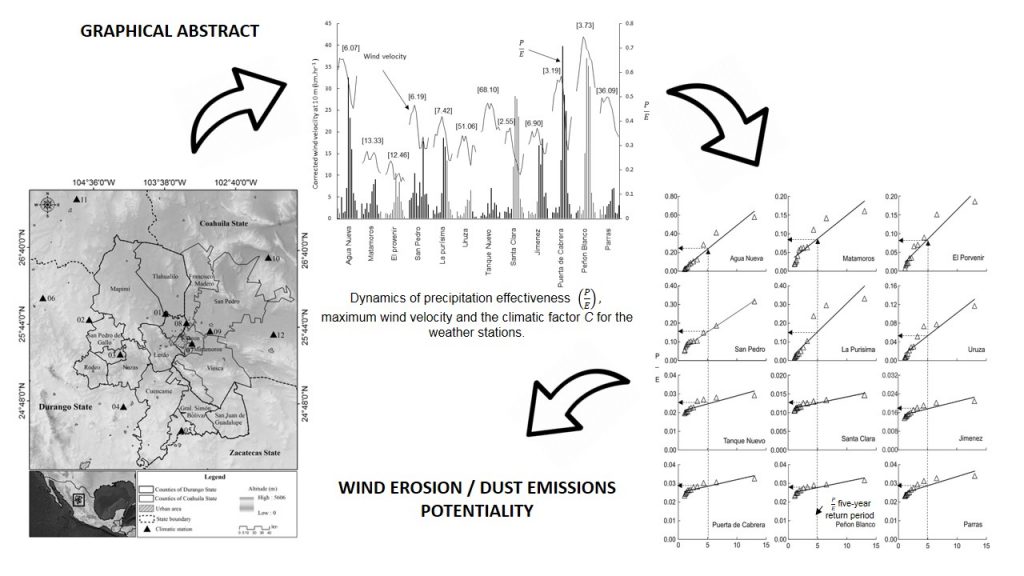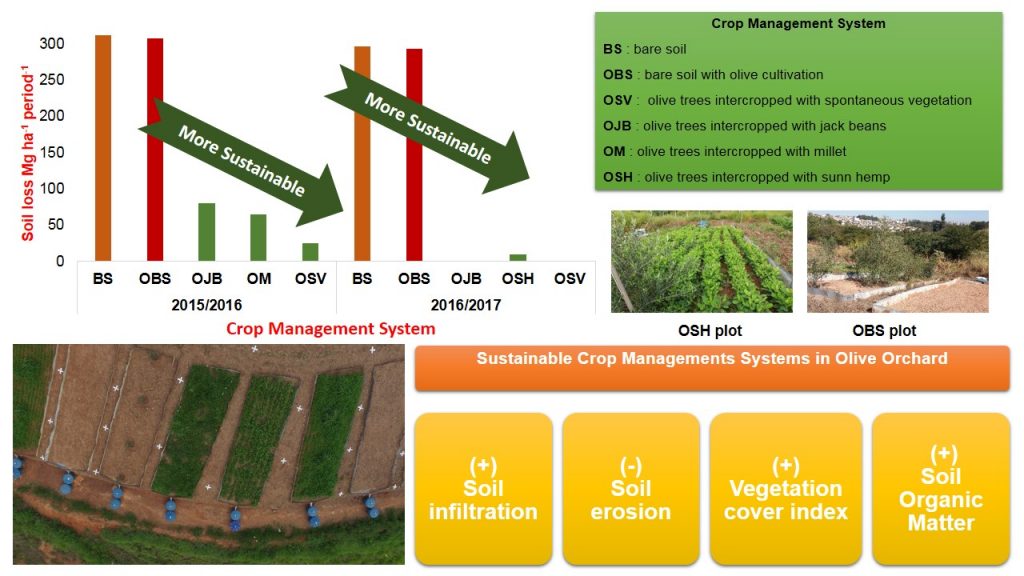Cover crops in between-rows of Coffea canephora for reduction of soil erosion
11/Mar/2025
ABSTRACT Soil erosion in tropical environments causes environmental, social and economic damage. Canephora coffee crops are impacted by soil erosion and testing alternatives to mitigate this damage is a current need. This study aimed to evaluate the losses of sediment, organic carbon, nutrients and surface runoff caused by water erosion in between-rows spacing of Coffea canephora Pierre ex A. Froehner plants in management with and without cover crops, and the effect of the intensity of rains on sediment loss and […]
Potential of wind erosion and dust emission in an arid zone of northern Mexico: A simple assessment method
16/Jul/2020
ABSTRACT Wind erosion is the main problem that arid lands in northern Mexico are facing. Quantification of this phenomenon is crucial for planning purposes and to scale its impact. The challenge is to assess the problem under limited availability of climatic information. This study aimed to identify potential areas of dust emissions in an arid zone of Northern Mexico. Wind direction and intensity were characterized through a robust index that involves rainfall and evaporation as well as the climatic factor […]
Assessment of soil erosion in olive orchards (Olea europaea L.) under cover crops management systems in the tropical region of Brazil
02/Apr/2020
ABSTRACT In the tropics, water erosion is one of the most important factors leading to the degradation and deterioration of agricultural land. Olive orchards have a low canopy coverage, especially during the first years after planting, due to the low density of olive trees. Given the fast expansion of olive orchards in Brazil, this study aimed to evaluate the effect of cover vegetation on soil and water losses under natural rainfall. In addition, it was assessed the crop performance and […]
Water Erosion in Oxisols under Coffee Cultivation
18/Jun/2018
ABSTRACT Water erosion is one of the main environmental impacts of land use. When soil and water losses occur, nutrients essential for the growth and maintenance of plants are removed, with harmful outcomes on the sustainability of agriculture and the environment. In addition, they lead to other deleterious effects, such as sedimentation and eutrophication of water bodies. Estimation of soil losses due to water erosion in sub-basins is essential for prediction of soil degradation, especially in areas of semi-intensive cultivation, […]
Soil Erodibility under Natural Rainfall Conditions as the K Factor of the Universal Soil Loss Equation and Application of the Nomograph for a Subtropical Ultisol
03/May/2018
ABSTRACT: Erodibility represents the intrinsic susceptibility of the soil to the erosion process, represented by the K factor in the Universal Soil Loss Equation (USLE). In Brazil, there are few field experiments determined with a series larger than ten years of data, which are the most reliable for quantifying the K factor. The aim of this study was to determine the K factor of the USLE by the direct method, relating soil losses determined in the field under standard conditions […]
Water Erosion in Different Slope Lengths on Bare Soil
20/Feb/2017
ABSTRACT Water erosion degrades the soil and contaminates the environment, and one influential factor on erosion is slope length. The aim of this study was to quantify losses of soil (SL) and water (WL) in a Humic Cambisol in a field experiment under natural rainfall conditions from July 4, 2014 to June 18, 2015 in individual events of 41 erosive rains in the Southern Plateau of Santa Catarina and to estimate soil losses through the USLE and RUSLE models. The […]
Soil water erosion under different cultivation systems and different fertilization rates and forms over 10 years
01/Dec/2014
The action of rain and surface runoff together are the active agents of water erosion, and further influences are the soil type, terrain, soil cover, soil management, and conservation practices. Soil water erosion is low in the no-tillage management system, being influenced by the amount and form of lime and fertilizer application to the soil, among other factors. The aim was to evaluate the effect of the form of liming, the quantity and management of fertilizer application on the soil […]
Erodibility of an inceptisol under natural rainfall
01/Dec/2014
Estimation of soil loss is critical to conservation planning. To make that estimation, use of the Universal Soil Loss Equation (USLE) is prominent in Brazil. For use of the USLE, there is a shortage of data obtained according to the standard method of this model. Among the factors that compose the USLE, soil erodibility (K factor) is difficult to obtain due to the need to conduct experiments in the field for a long time under natural rainfall. Aiming to quantify […]
Influence of the surface conditions and soil cultivation on water erosion in an inceptisol
01/Oct/2014
The soil cover by crop residues dissipates the kinetic energy of raindrops, while, the surface roughness dissipates the kinetic energy of runoff, therefore, both store water and retain sediments on surface, decreasing water erosion. The objective of this study was to determine the persistence and the influence of crop residues and surface roughness in cultivated soil on soil and water losses, compared to bare and uncovered soil under the following treatments: i) cultivated soil: covered by ryegrass mulch (Lolium multiflorum), […]
Assessment of the erosive potential of rainfall in Urussanga, Santa Catarina, Brazil from 1980 to 2012
01/Jun/2014
Knowledge of the erosive potential of rainfall and its distribution throughout the year contribute to planning management and soil conservation practices that aim to reduce water erosion, decreasing soil loss and increasing crop yields. The goal of this study is to characterize rainfall in the region of Urussanga, SC, Brazil, in relation to its erosive potential, determining monthly and annual Erosivity Indices (EI30), thus establishing the R factor to use in the Universal Soil Loss Equation. In addition, the goal […]



